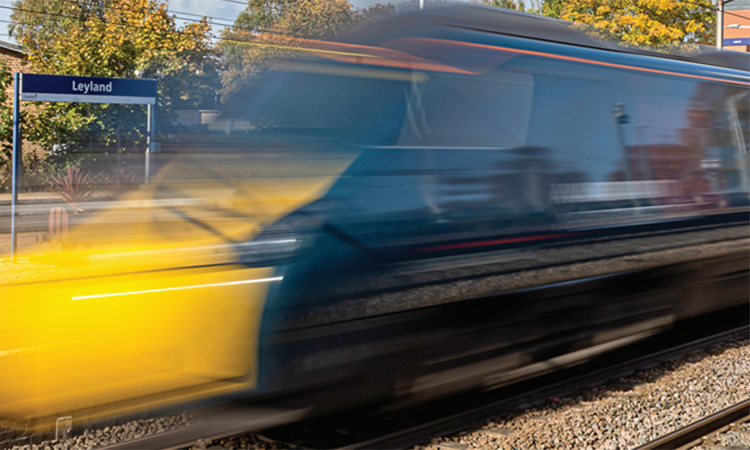Q&A with RIA’s David Clarke: Decarbonisation in rail
Posted: 2 June 2023 | David Clarke | No comments yet
During Railtex 2023, Global Railway Review sat down with David Clarke, Technical Director of RIA, to discuss decarbonisation in the rail industry and what RIA are doing to help meet its targets.


Credit: RIA
Can you give us an overview of what you and the RIA are doing here at Railtex?
At the practical level, the Railway Industry Association (RIA) is at Railtex for the future focus conference and the innovation village. At the strategic level, we’re here to support our members who are exhibiting to raise the profile of the supply chain with key decision makers. Through the people we’re inviting to the innovation conference, we’re trying to raise the profile of the rail supply chain as a major part of the economy.
Can you talk a little bit about the importance of decarbonisation for the rail industry?
The importance is that we have a climate emergency. As with all sectors, we are committed to becoming net zero carbon by 2050 or sooner. However, this is challenging for the transport sector because it is the only sector where carbon emissions are growing, as people want to travel more. So, demand is rising and carbon emissions are growing.
Rail is approximately only 1.4% of transport emissions, yet it carries around 10% of passengers.
Rail is approximately only 1.4% of transport emissions, yet it carries around 10% of passengers. Already it is a strong low carbon mode of transportation. Rail is also special in that it already has a ready-made and proven solution to decarbonisation. Most of that would be electrification, but also with battery.. Rail is currently able to decarbonise, whereas some other sectors must do more development in R&D and build up their industrial capability to be able to decarbonise.
Our strong argument is that we should, as an industry, be getting on with it. Of course, the challenge is that there’s a significant upfront cost to that, and that comes back to the Exchequer. We say there’s opportunities to use private finance, but it still needs decisions to be made, and at the moment we’re not seeing this happen, which means that the transport mode that is already green could start falling behind all other modes.
My argument is always that where you can save carbon, you should save as soon as you can, because every day you run a train, it’s emitting carbon. Assuming you stop emitting carbon, those savings are cumulative. If we save a tonne of carbon in 2023, we’ve saved 27 tonnes by 2050, because it’s a tonne a year for 27 years.
What positives are you seeing at Railtex related to decarbonisation?
At Railtex, decarbonisation is on everybody’s lips, it’s something that everybody’s talking about. It’s something that individual businesses all have their own decarbonisation agenda for, as is clear if you talk to any of the stands here. If you have external investors, your environmental social governance requirements will require you to have those measures in place, and it’ll be bad for business if you don’t. As I said, rail is essentially a green industry, and there’s a very high awareness of that within the sector. Generally speaking for businesses, being green can save you money. It’s quite likely, after the initial investment, to save you money. In the longer run, it’s absolutely essential because key customers will not be buying from people who can’t demonstrate that they themselves are zero carbon.
What are the biggest barriers to meeting decarbonisation targets?
The key challenge at the moment is for us to progress at the rate we need to in order to hit net zero carbon by 2050.
Well across all sectors, I think the targets are having the technology to reduce carbon. As I mentioned earlier, rail is quite fortunate in that we do have the technology. But then that brings us to the second challenge, which is funding. And the third challenge, which is not unique to rail, key decisions need to be made as we are at least partially funded by government.
The key challenge at the moment is for us to progress at the rate we need to in order to hit net zero carbon by 2050, because we’re not yet doing the volume of electrification. For example, we’re not yet seeing fleet orders of low carbon or zero carbon trains like battery and hydrogen trains. Back to my previous point, if we wait, we’re not saving carbon. And if we wait, we’re also potentially putting the cost up, because as with anything, if you backend load a programme rather than spread it over 15 years instead of 27 years, it’s likely to be more expensive.
Tell us a little bit about RIA’s RailDecarb23 campaign and what it aims to achieve.
Our RailDecarb23 programme is all about highlighting the need to make decisions, to try and get started on the journey to net zero and to save carbon as early as we possibly can. Also, to ensure that rail and the businesses supporting rail maintain our competitive advantage and play our part in public transport. The most useful thing we can do as rail, beyond decarbonising ourselves, is offer a really good service to our passenger and freight users, so that we see modal shift. Every freight train, for example, takes 76 lorries off the road. So, if we can encourage people, passengers and freight to move from other modes to rail, we are helping the other modes to decarbonise.
Our RailDecarb23 programme is all about highlighting the need to make decisions, to try and get started on the journey to net zero and to save carbon as early as we possibly can.
Within the Decarb23 campaign we have three asks, which are supporting the need to make decisions. One is an immediate start to a rolling programme of cost effective electrification, because as I said earlier, there’s 27 years to go. There’s quite a lot of work to be done. The sooner we start it, the more cost effective it’ll be, and the sooner we’ll make savings.
Our next ask is for fleet orders of low carbon rolling stock, be it battery or hydrogen, or indeed other technologies. The reason for that is twofold. One is, you get immediate carbon savings, and back to my point about cumulative carbon savings, it also stimulates a new market.
Our third ask, which is a new ask, is about not penalising suppliers who come up with low carbon alternatives or zero carbon alternatives to the conventional way of doing things. This applies to infrastructure as well as rolling stock. What we are seeing is suppliers with innovative proposals to reduce carbon, not having these accepted because they’re higher cost in the short run. This is incredibly short sighted, because of the long life of railway; if we buy something today that is a conventional technology, that’s a high carbon technology, then we’re embedding that for decades.
In addition, if we think a little bit of upfront initial pump priming costs, we’ll allow the volumes to grow to bring the cost down to a comparable level with the conventional technologies. But we’re in a chicken and egg situation, where no orders keep the costs higher.
Ultimately, it’s really important that we get some decisions made to allow the rail industry to maintain its role as a key driver for public and freight transport. And actually, to offer more to drive modal shift. We need decisions made as soon as possible around a rolling programme of electrification, fleet orders of low carbon rolling stock, and that third ask about not penalising suppliers that come up with temporarily more costly low carbon solutions.


David Clarke joined RIA in 2016 as the Technical Director. His role focuses on representing members interests in the important areas of safety, technical standards, technical strategy, research and innovation.








